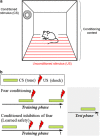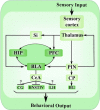Learning not to fear: neural correlates of learned safety
- PMID: 23963118
- PMCID: PMC3895233
- DOI: 10.1038/npp.2013.191
Learning not to fear: neural correlates of learned safety
Abstract
The ability to recognize and properly respond to instances of protection from impending danger is critical for preventing chronic stress and anxiety-central symptoms of anxiety and affective disorders afflicting large populations of people. Learned safety encompasses learning processes, which lead to the identification of episodes of security and regulation of fear responses. On the basis of insights into the neural circuitry and molecular mechanisms involved in learned safety in mice and humans, we describe learned safety as a tool for understanding neural mechanisms involved in the pathomechanisms of specific affective disorders. This review summarizes our current knowledge on the neurobiological underpinnings of learned safety and discusses potential applications in basic and translational neurosciences.
Figures




References
-
- Baker AG. Conditioned inhibition is not the symmetrical opposite of conditioned excitation: a test of the Rescorla–Wagner model. Learn Motiv. 1974;5:369–379.
-
- Bouton ME, Westbrook RF, Corcoran KA, Maren S. Contextual and temporal modulation of extinction: behavioral and biological mechanisms. Biol Psychiatry. 2006;60:352–360. - PubMed
-
- Cándido A, González F, Brugada ID. Safety signals from avoidance learning but not from yoked classical conditioning training pass both summation and retardation tests for inhibition. Behav Process. 2004;66:153–160. - PubMed
Publication types
MeSH terms
Grants and funding
LinkOut - more resources
Full Text Sources
Other Literature Sources

